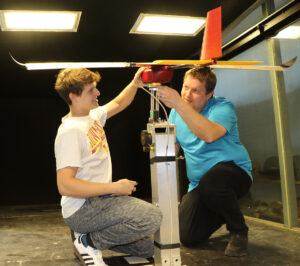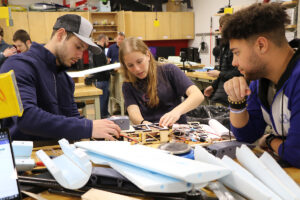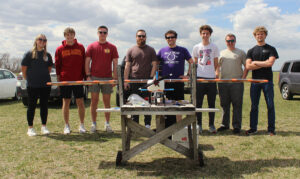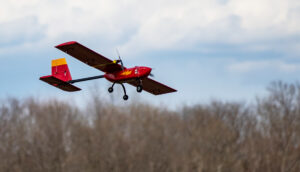Putting it all together: teamwork and technical knowledge work together in aerospace engineering’s senior design courses
Author: John Burnett-Larkins
Author: John Burnett-Larkins
“I’m trying to take all the things students have learned in all their different classes and teach them that this is how we can get it all put together.”

It’s the final undergraduate challenge for Department of Aerospace Engineering seniors in required courses AER E 4610 (“Modern Design Methodology With Aerospace Applications,” fall semester) and 4620 (“Design of Aerospace Systems,” spring semester), better known as “senior design.” Associate teaching professor Travis Grager leads student teams through a process of constructing uncrewed aerial vehicles (UAVs) – remote controlled aircraft – from start to finish – with flight tests being the final requirement. There are two branches of senior design, with Grager leading the aircraft section. There is also an option for spacecraft design. Students pick which they want to pursue.
At the beginning of fall semester Grager supplies all the information the students need. “They get a list of requirements and a lot of tools they can use to design their aircraft. I give them a somewhat realistic scenario for a UAV mission they are designing around and give them information such as how big the aircraft needs to be, weight limits, how fast or slow it needs to fly and the payload it needs to be carrying to complete a mission.”

Planning and designing the aircraft comes first in the fall semester. In the second semester things turn to actual construction, testing of the wings of the aircraft in a wind tunnel, testing of motors and how each team’s craft will actually fly. Team size varies from five to as much as 10 or 11 in the case of teams that are assigned to design more than one plane.
“They’re building the craft for probably a good month. Then they go through a flight readiness check – we make sure the craft isn’t going to fall apart – and then test many components to validate that everything is set to hopefully offer a successful test flight,” says Grager. There are meetings, presentations and reports along the way, with Grager acting as a “customer” the team is accountable to. Each team also has to submit a written report before anything is built – “I call it the “design sign off report,” says Grager. “It details how they are going to build it and how the plane is actually going to fly.”

Parts for the construction come from many sources, including online ordering, requesting parts to be manufactured by the department’s wood shop, ordering 3D-printed parts to be created by the department’s Make to Innovate lab, doing their own 3D printing with equipment in the Student Innovation Center and use of the department’s composites lab.
This year a new component was added for the first time: equipping each plane with an autopilot feature. “Essentially the airplane should be able to fly itself. We want the aircraft to take off on its own and land completely. It’s been a learning process,” Grager reports.
Fight tests are done at a remote control aircraft flying site near Cambridge. Teams make the trip a few at a time on different days. Experienced remote control aircraft pilots actually fly the planes. “Through the autopilots we are able to collect data of all the commands going to the aircraft as well as get data from the planes during the flights to see how fast it is making turns, what speed it was flying, altitude, things like that, Grager comments. “Then we can evaluate everything and see what corrections need to be made to the aircraft.” Flight times can vary anywhere from three minutes to upwards of ten minutes.

Through it all, teamwork is the most important factor, and prepping the soon-to-be graduates with important skills for the job world. “All the team capabilities the students develop can be applied to any job after graduation. Graduates might be working on many different styles of aircraft or spacecraft. An important part of this is how to think about more than just one discipline as you are designing something,” Grager confirms. “In all their previous classes they were focusing on just one thing at a time, like structure or propulsion. Now it becomes a matter of how to balance all those components and having people of different skill sets come together.”